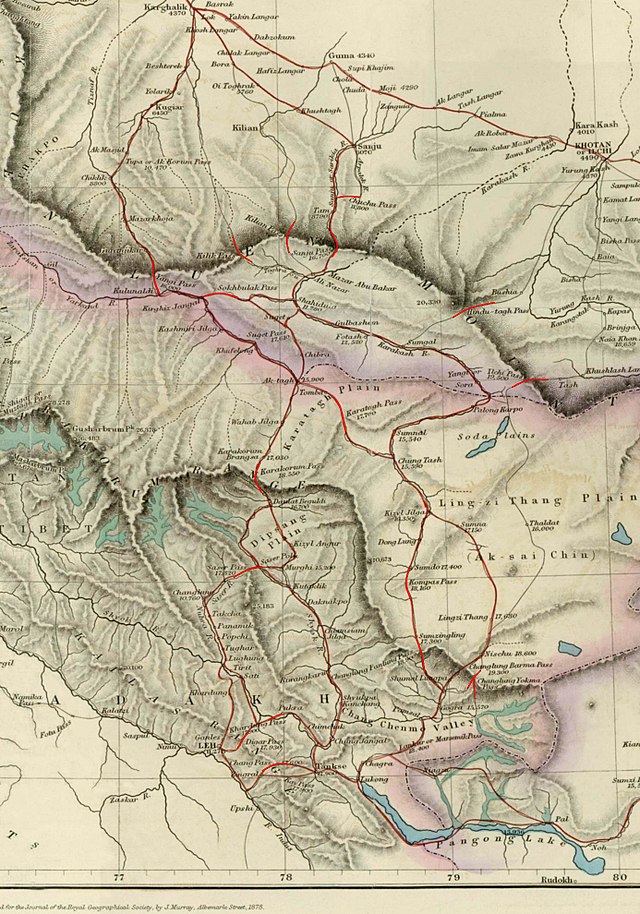Top Qs
Timeline
Chat
Perspective
Hindutash Pass
Mountain pass in Xinjiang, China From Wikipedia, the free encyclopedia
Remove ads
Hindu-tagh Pass, also known as Hindutash, is a historical mountain pass in the western Xinjiang, China. The pass cuts through the Kunlun Mountains connecting the now-deserted town of Kangxiwar in the Karakash River valley to the town of Pusha in the Pusha Jilga valley (36.3833°N 79°E; formerly Bushia). It also connects to the road to the city of Hotan (formerly Khotan or Ilchi; see adjacent maps).[1]


![]() G580 is under construction connecting Kangxiwar directly with Hotan.[2] It will tunnel under Hindutash, connect with the Xinjiang-Tibet Highway G219 to the south after numerous hairpin turns.[3] It is scheduled to be completed in 2022.[4][needs update]
G580 is under construction connecting Kangxiwar directly with Hotan.[2] It will tunnel under Hindutash, connect with the Xinjiang-Tibet Highway G219 to the south after numerous hairpin turns.[3] It is scheduled to be completed in 2022.[4][needs update]
"Hindu-tagh" means "Indian Mountain," and "Hindu-tash," "Indian stone" in the Uyghur dialect of Xinjiang.
Remove ads
History
In 1857, the explorer Robert Schlagintweit crossed this pass from camping grounds in Sumgal ("three fords"), on the banks of the Karakash river, approximately 7 miles (11 km) upstream from Kengshewar and estimated its height to be 17,879 ft (5,450 m). At the top of the pass (36°16′23″N 78°46′50″E), there is a steep glacier with many crevasses. The eastern Kunlun range, which is in the southern region of the Hotan prefecture of Xinjiang, is cut by two other passes: the Sanju Pass, near the small staging post of Xaidulla, formerly Shahidulla, northwest of Hindu-tagh, and the Ilchi Pass, southeast of Hindu-tagh, just north-east of the village of Dahongliutan, itself just north of the now disputed Aksai Chin area (see second map on right). The former pass had been much used historically, and provided the traditional means of entry from the south into the ancient Kingdom of Khotan. The latter was traversed in 1865 by W. H. Johnson of the Survey of India.
Remove ads
Gallery
- "The Chain of the Kuenlúen, from Súmgal, in Turkistán (Lat North 36° 8', Long. East of Green. 78° 5', Height 13, 215 Engl. feet)" by Hermann Schlagintweit, August 1856. Lithographed by Sabatier, printed in oil-colours by Lemereier, Paris. The Hindu-tagh Pass is the break in the mountains on the right.
- Yarkand River in the Western Kunlun Range, seen from the Xinjiang-Tibet Highway
- View of Western Kunlun Range from the Xinjiang-Tibet Highway
Remove ads
Maps
- A lower-resolution 1909 Map of the Princely State of Kashmir and Jammu. Sumgal in the valley below the Hindu-tagh Pass is shown in the top right corner.
- Map of Aurel Stein (1911) based on that of the Survey of India showing the "Hindutash Dawan" in the Kunlun Mountains
See also
Notes
References
Wikiwand - on
Seamless Wikipedia browsing. On steroids.
Remove ads









